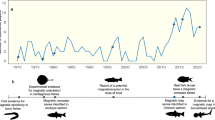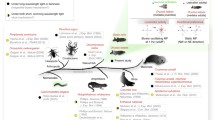Abstract
Loggerhead sea turtles (Caretta caretta) derive both directional and positional information from the Earth’s magnetic field, but the mechanism underlying magnetic field detection in turtles has not been determined. One hypothesis is that crystals of biogenic, single-domain magnetite provide the physical basis of the magnetic sense. As a first step toward determining if magnetite is involved in sea turtle magnetoreception, hatchling loggerheads were exposed to pulsed magnetic fields (40 mT, 4 ms rise time) capable of altering the magnetic dipole moment of biogenic magnetite crystals. A control group of turtles was treated identically but not exposed to the pulsed fields. Both groups of turtles subsequently oriented toward a light source, implying that the pulsed fields did not disrupt the motivation to swim or the ability to maintain a consistent heading. However, when swimming in darkness under conditions in which turtles normally orient magnetically, control turtles oriented significantly toward the offshore migratory direction while those that were exposed to the magnetic pulses did not. These results are consistent with the hypothesis that at least part of the sea turtle magnetoreception system is based on magnetite. In principle, a magnetite-based magnetoreception system might be involved in detecting directional information, positional information, or both.



Similar content being viewed by others
References
Batschelet E (1981) Circular statistics in biology. Academic, New York
Beason RC, Dussourd N, Deutschlander ME (1995) Behavioural evidence for the use of magnetic material in magnetoreception by a migratory bird. J Exp Biol 198:141–146
Beason RC, Wiltschko R, Wiltschko W (1997) Pigeon homing:Effects of magnetic pulses on initial orientation. Auk 114:405–415
Deutschlander ME, Phillips JB, Borland SC (1999) The case for light-dependent magnetic orientation in animals. J Exp Biol 202:891–908
Diebel CE, Proksch R, Green CR, Neilson P, Walker MM (2000) Magnetite defines a vertebrate magnetoreceptor. Nature 406:299–302
Irwin WP, Lohmann KJ (2003) Magnet-induced disorientation in hatchling loggerhead sea turtles. J Exp Biol 206:497–501
Kalmijn AJ (1974) The detection of electric fields from inanimate and animate sources other than electric organs. In: Fessard A (ed) Handbook of sensory physiology, 3A edn. Springer-Verlag, Berlin Heidelberg New York, pp 147–200
Kalmijn AJ (1978) Experimental evidence of geomagnetic orientation in elasmobranch fishes. In: Schmidt-Koenig K, Keeton WT (eds) Animal migration, navigation and homing. Springer, Berlin Heidelberg New York, pp 135–142
Kirschvink JL (1983) Biogenic ferrimagnetism: a new biomagnetism. In: Williamson SJ, Gian-Luca R, Lloyd K, Modena I (eds) Biomagnetism: an interdisciplinary approach. Plenum, New York, pp 501–531
Kirschvink JL, Gould JL (1981) Biogenic magnetite as a basis for magnetic field detection in animals. BioSystems 13:181–201
Kirschvink JL, Walker MM, Chang SB, Dizon AE, Peterson KA (1985) Chains of single-domain magnetite particles in Chinook salmon, Oncorhynchus tshawytscha. J Comp Phys A 157:375–381
Kirschvink JL, Walker MM, Diebel CE (2001) Magnetite-based magnetoreception. Curr Opin Neurobiol 11:462–467
Leask MJM (1977) A physicochemical mechanism for magnetic field detection by migratory birds and homing pigeons. Nature 267:144–145
Light P, Salmon M, Lohmann KJ (1993) Geomagnetic orientation of loggerhead sea turtles: evidence for an inclination compass. J Exp Biol 182:1–10
Lohmann KJ (1991) Magnetic orientation by hatchling loggerhead sea turtles (Caretta caretta). J Exp Biol 155:37–49
Lohmann KJ, Cain SD, Dodge SA, Lohmann CMF (2001) Regional magnetic fields as navigational markers for sea turtles. Science 294:364–366
Lohmann KJ, Johnsen S (2000) The neurobiology of magnetoreception in vertebrate animals. TINS 24:153–159
Lohmann KJ, Lohmann CMF (1994a) Acquisition of magnetic directional preference in hatchling loggerhead sea turtles. J Exp Biol 190:1–8
Lohmann KJ, Lohmann CMF (1994b) Detection of magnetic inclination angle by sea turtles: a possible mechanism for determining latitude. J Exp Biol 194:23–32
Lohmann KJ, Lohmann CMF (1996) Detection of magnetic field intensity by sea turtles. Nature 380:59–61
Lohmann KJ, Lohmann CMF (2003) Orientation mechanisms of hatchling loggerheads. In: Bolten A, Witherington B (eds) Loggerhead sea turtles. Smithsonian Institution Press, Washington, pp 44–62
Marhold S (1997) Magnetic orientation in the common mole-rats from Zambia. In: RIN97. Royal Institute of Navigation, Oxford, Paper No. 5
Munro U, Munro JA, Phillips JB, Wiltschko R, Wiltschko W (1997) Evidence for a magnetite-based navigational “map” in birds. Naturwissenschaften 84:26–28
Phillips JB, Borland SC (1992) Behavioural evidence for use of a light-dependent magnetoreception mechanism by a vertebrate. Nature 359:142–144
Ritz T, Adem S, Schulten K (2000) A model for photoreceptor-based magnetoreception in birds. Biophys J 78:707–18
Ritz T, Dommer DH, Phillips JB (2002) Shedding light on vertebrate magnetoreception. Neuron 34:503–506
Ritz T, Thalau P, Phillips J, Wiltschko R, Wiltschko W (2004) Resonance effects indicate a radical pair mechanism for avian magnetic compass. Nature 429:177–180
Salmon M, Wyneken J (1987) Orientation and swimming behavior of hatchling loggerhead turtles Caretta caretta L. during their offshore migration. J Exp Mar Biol Ecol 109:137–153
Salmon M, Wyneken J (1994) Orientation by hatchling sea turtles: mechanisms and implications. Herp Nat Hist 2:13–24
Schulten K, Windemuth A (1996) Model for a physiological magnetic compass. In: Maret G, Kiepenheuer J, Boccara N (eds) Biophysical effects of steady magnetic fields. Springer, Berlin Heidelberg New York, pp 99–106
Walker MM, Diebel CE, Haugh CV, Pankhurst PM, Montgomery JC, Green CR (1997) Structure and function of the vertebrate magnetic sense. Nature 390:371–376
Wiltschko R, Wiltschko W (1995a) Magnetic orientation in animals. Springer, Berlin Heidelberg New York
Wiltschko W, Wiltschko R (1995b) Migratory orientation of European robins is affected by the wavelength of light as well as by a magnetic pulse. J Comp Physiol A 177:363–369
Wiltschko W, Wiltschko R (1999) The effect of yellow and blue light on magnetic compass orientation in European robins, Erithacus rubecula. J Comp Physiol A 184:295–299
Wiltschko W, Wiltschko R (2001) Light-dependent magnetoreception in birds: the behaviour of European robins, Erithacus rubecula, under monochromatic light of various wavelengths and intensities. J Exp Biol 204:3295–3302
Wiltschko R, Wiltschko W (2003) Avian navigation: from historical to modern concepts. Anim Behav 65:257–272
Wiltschko W, Munro U, Ford H, Wiltschko R (1993) Red-light disrupts magnetic orientation of migratory birds. Nature 364:525–527
Wiltschko W, Munro U, Beason RC, Ford H, Wiltschko R (1994) A magnetic pulse leads to a temporary deflection in the orientation of migratory birds. Experientia 50:697–700
Wiltschko W, Munro U, Ford H, Wiltschko R (1998) Effect of a magnetic pulse on the orientation of silvereyes, Zosterops l. lateralis, during spring migration. J Exp Biol 201:3257–3261
Wiltschko W, Munro U, Wiltschko R, Kirschvink JL (2002) Magnetite-based magnetoreception in birds: The effect of a biasing field and a pulse on migratory behavior. J Exp Biol 205:3031–3037
Witherington BE, Bjorndal KA, McCabe CM (1990) Temporal pattern of nocturnal emergence of loggerhead turtle hatchlings from natural nests. Copeia 1990:1165–1168
Acknowledgments
We thank Mike Salmon and Jeanette Wyneken for helpful discussions, logistical support, and providing laboratory space in Florida. We also thank Lou Fisher, Stefanie Ouellette and the NSU sea turtle hatchery crew for assistance with obtaining hatchlings. Experiments comply with the Principles of animal care publication No. 86–23, revised 1985, of the National Institutes of Health. Experiments were authorized under Florida DEP sea turtle permit#065.
Author information
Authors and Affiliations
Corresponding author
Rights and permissions
About this article
Cite this article
Irwin, W.P., Lohmann, K.J. Disruption of magnetic orientation in hatchling loggerhead sea turtles by pulsed magnetic fields. J Comp Physiol A 191, 475–480 (2005). https://doi.org/10.1007/s00359-005-0609-9
Received:
Revised:
Accepted:
Published:
Issue Date:
DOI: https://doi.org/10.1007/s00359-005-0609-9




